
Investing in the Indigenous Estate
I would like to begin by acknowledging the Traditional Owners of the land on which we meet: – the Wurundjeri, Boonwurrung, Taungurong, Dja Dja Wurrung and the Wathaurung people who make up the Kulin Nation. I pay my respect to Elders Past and Present.
I have been asked to lay out my thoughts about Unlocking the Indigenous Estate in relation to Indigenous investment, the current landscape and where we need to go in the future.
I believe there are three crucial questions PBCs need to ask about investment and how they might apply in relation to developing the Indigenous Estate.
- What makes a PBC or PBC business proposition attractive to a potential investor or lender?
- What are the ways in which PBCs can invest (either cash or entrepreneurial)?
- What should a PBC look for in an investor?
Unlocking the Indigenous Estate
At the National Native Title Conference in Darwin earlier this year I spoke about Unlocking the Indigenous Estate if we are to realise economic development for our people.
I spoke to the need to define the Indigenous Estate and to ensure there is a shared understanding of what it comprises and how it can best be mobilised for the collective benefit of Indigenous people.
There is a growing desire among us to work together to maximise the opportunities for intergenerational wealth, in all of its forms, which can flow from the Indigenous Estate.
Such prosperity will underpin our wellbeing and ensure the long-term survival of Indigenous culture and values; and this is the vision of the ILC and IBA – both organizations of which I am the Chair.
Building the Indigenous Estate with a high level of planning and collaboration will position the Indigenous Estate as a source of value for our people and Australia as a whole: a complex entity that is well run and a natural partner for investors.
As we tend to the business of unlocking value of the Indigenous Estate we will seek the engagement and participation of our Governments, Business Corporations and Indigenous Organisations including PBC’s to enhance the prosperity of Indigenous Australians.
Where to from here for PBCs?
The role of Traditional Owners, Native Title holders and PBCs and their ability to plan, collaborate and attract investment into the Indigenous Estate, will be crucial if we are to turn our 40% stake in the Australian land mass, into a major pipeline of activity which can deliver long term benefits and well-being.
I recommend the IBA’s Indigenous Investment Principles for your consideration.
Launched in December last year and crafted by Representatives from more than 40 Indigenous organisations, the principles provide an investment framework for Aboriginal and Torres Strait Islander organisations and communities to create intergenerational wealth.
The framework encourages decision-making that is based on accurate, independent information and free from any undue influence. I urge you to familiarise yourself with this framework.
Now to the Specific Questions:
What makes a PBC attractive to a potential investor or lender?
The simple answer is you have to have a product that fits the business appetite of the investor.
A business proposal should sell itself assuming that; the targeted market is in a growth phase or presents as ‘strong’ over lead times sufficient to repay the investment and provide a dividend on maturing the loan.
The challenge then is in the details; any business proposal is made up of two key elements; the business or venture you are seeking investment in, and your corporation and its capacity to deliver your proposed venture.
This second element is especially relevant to PBCs which may be relatively new entities, with few ‘runs on the board’ from an investor’s perspective.
Market-based investors may not similarly invest in long-term capacity building relationships – this means that PBCs must get their corporate settings right before seeking investment; strong governance and commercial acumen creates investor confidence with invested capital as the result.
PBCs have struggled with appropriate access to resources for building governance and commercial expertise.
The Department of Prime Minister and Cabinet is now providing funds for “Capacity Building for Native Title Corporations”.
These funds are administered through the Indigenous Advancement Strategy and are targeted towards enabling PBCs to take better advantage of economic opportunities.
I encourage you to explore this funding opportunity. Work with Native Title Service Providers and other peak bodies to develop the skills and expertise that will give investors confidence that your PBCs can deliver on their business plans.
With good governance established, it will be time for good ideas.
What ventures should your PBC seek investment for?
These decisions are critical and specific to your PBC, your peoples’ aspirations and the resources and attributes of your country.
I am not going to pretend that there is a single answer for everyone, but to arrive at the answer; I can recommend you start by asking yourself the following:
- Is the proposed investment consistent with your goals and investment strategy for the long-term?As PBC representatives you are charged to consider what are the impacts of business proposals now and in the future.
And - Is the business idea consistent with your core business? Is the market already overcrowded with other operators – where do you think the opportunity exists?
If the answer to these questions is ‘Yes’, then I believe you are considering a business venture that is a sound fit for your Corporation and your member’s aspirations.
These ideas require diligent planning, viability assessment and clear business plans to attract an investor.
If they demonstrate ‘proof of concept’ and are paired with a well-governed entity; investors should see their interest furthered by supporting your interests.
Moving on to our next question: What are the Ways that PBCs can invest?
I cannot tell you what to invest in, nor would I pretend to.
But, I can tell you how I see the world and offer my thoughts on how you could proceed from here.
Let’s work our way through the investment process.
The Motivation – you have an idea. It’s a light bulb flash and it gets brighter and brighter and begins to consume your thinking.
Your Core Business – answers the “should we invest in this?” question. Is the investment idea consistent with your core business? Is the market already overcrowded? – where do you think the opportunity exists?
A Financial Roadmap – answers the “how much can/should we invest?” questions.
Prior to making any decision regarding investing in a business concept or placing your available funds into the hands of a fund manager, realistically map out your financial position.
Establish the full timeline of your revenue stream. You might have single one-off receipts or your inflow of revenue is linked to a royalty arising from an ILUA over many years.
What type of Investment class to invest in?
This can be in part determined by a PBC’s Risk Appetite – What do you think yours is? Have you questioned yourself on this aspect of managing your investments? Every investment has an element of risk.
- Low risk investments such as cash equivalents may suit your short term financial requirements as these are stable types of investment and generally will deliver a reliable positive return.
- High risk Investments may be attractive as the upside of risk is the prospect of higher investment returns. Financial goals with long time horizons may be better suited to higher risk investment choices as risk can be balanced over time.
No matter your risk appetite, it is prudent to always consider your Investment mix. The time-honoured saying “Don’t put all your eggs in the one basket” is still relevant.
Whether it’s your direct investment into a business producing and selling a product or placing your funds into the hands of your fund manager, having a mix of asset classes can help your investment returns to average out as market conditions rise and fall.
Three main Classes of product:
Cash Investments; this means using your existing cash to establish an investment portfolio through cash markets and generally a fund manager.
Investing in Entrepreneurial activity; Investing in a material business producing a product for sale.
Investing in the Intellectual Property of People; I see intellectual property as an additional class of investment.
Indigenous businesses and individuals will need to move with the digital age to take part in new industries, employment opportunities, and career paths and reshape how wealth is created and transferred generationally within the Indigenous Estate.
It’s important that Indigenous businesses and people are positioned to engage and participate so that we can blend existing and future opportunities.
We need to get our settings right around the education platform of our people to engage and participate.
We need to invest in our people.
Our thinking about investment decisions needs to extend into the development of our Intellectual Property to secure the business opportunities of non-traditional industries, markets and employment.
To do this we need to understand where our future opportunity may reside.
It may be that PBCs should invest some of their money in the development of our young people as a way of future-proofing their own organization and developing leaders for the future.
I believe we need to encourage more of our young people to take up STEM-related study.
STEM is the acronym for Science, Technology, Engineering and Mathematics.
We have a duty to do the best we can for indigenous Australians to compete in the market space for business activity and employment that will give us a chance to reach an acceptable level of wellbeing.
You could at this point be thinking – Yes, all very interesting but how does this relate to investments?
My view is that in the future your investment choices will be very different to what they are today.
We will need to have our own people trained in specialist fields if we are to operate successful businesses or be truly equal partners in an enterprise.
Our people need to be trained as environmental scientists, software designers, mining experts, finance and accounting advisers, engineers – the list and opportunity is huge but it goes back to my central point – we must invest in our own people.
And now to the final question – What should a PBC look for in an Investor?
Investors come in many forms and let’s assume as a PBC you have a product that has passed “Proof of Concept” and convinced an investor you have the requisite governance and capabilities to realize the business.
As a PBC, what you are looking for from an investor is no different to what the investor wants from the PBC – a firm partnership built on respect, relationship and a commitment to work for the same agreed outcomes, which is to get a return on the investment.
But, PBCs will also ideally be seeking an investor who similarly values the ‘co benefits’ or ‘social returns’ of their investment.
Many PBC businesses will have an explicit social impact function.
Whether it is employment and training of local Indigenous people, biodiversity conservation in rangeland management practices or cultural site preservation alongside tourism ventures, the Indigenous Estate requires of us more than a simple commercial transaction.
Our arrangements must be commercial, but they must also be more.
We want investors to invest in the intergenerational trust of the Indigenous Estate as well as in the market term profits.
Closing:
In closing let’s revisit some of the key questions you must ask yourselves.
First and foremost what is attractive to you?
If the numbers stack up and the business model is sound, you won’t have much difficulty finding an investor because they are after the same thing as you – a return on investment.
On ways to invest, as I have already indicated – funds management, a business producing a product such as an agribusiness, tourism or real estate development and the third – in your own Intellectual Property.
On the question of what should a PBC look for in an investor? – it’s no different to what the investor wants from the PBC – a firm partnership built on respect, relationship and an unbending commitment to work for the same agreed outcomes which is to get a financial return on the investment.
Unlocking the Indigenous Estate through investment requires the collaboration of PBCs.
Partnerships will be the key to success.
Investors must invest in more than profit shares, but also the social and co-benefit impacts of unlocking the Indigenous Estate.
My final comment is that our specific target at this point in time, is to establish a collaborative framework for sustained intergenerational transfer of Indigenous wealth.
Uniformity in our approach will help layout how we do business and how we conduct ourselves as partners.
This is not just about assets and materials, but also about our intellectual property underwritten by thousands of years of living in this great country – and not just for ourselves as Indigenous Australians – but for the whole of the Nation.
Thank you

